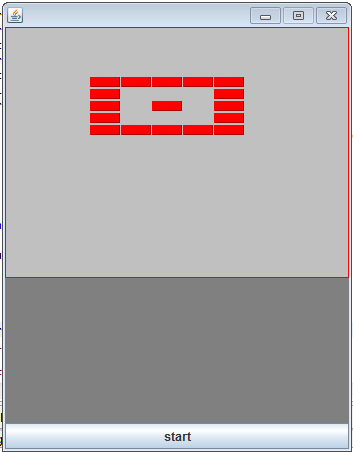import java.awt.BorderLayout;
import java.awt.Color;
import java.awt.Graphics;
import java.awt.Rectangle;
import java.util.ArrayList;
import javax.swing.JButton;
import javax.swing.JFrame;
import javax.swing.JPanel;
public class Bricks extends JPanel implements Runnable {
// variables declaration for brick...............................
//starting position of the bricks
int brickx = 85;
int bricky = 50;
//You can specify length and breadth of the bricks here
int brickBreadth = 50;
int brickHeight = 40;
// variables declaration for brick...............................
// ===============================================================
private static final String[] LEVELS_ONE = new String[] {
"WWWWW",
"W W",
"W W W",
"W W",
"WWWWW"
};
private static final String[] LEVELS_TWO = new String[] {
"WWWWW",
" ",
"W W W",
" ",
"WWWWW"
};
ArrayList<Rectangle> Brick = new ArrayList<Rectangle>();
Thread t;
Bricks() {
setFocusable(true);
t = new Thread(this);
t.start();
}
public static void main(String[] args) {
JFrame frame = new JFrame();
Bricks game = new Bricks();
JButton restart = new JButton("start");
// JLabel lbl_startGame = new JLabel("Start Game", JLabel.LEFT);
frame.setSize(350, 450);
frame.setDefaultCloseOperation(JFrame.EXIT_ON_CLOSE);
frame.add(game);
frame.add(restart, BorderLayout.SOUTH);
frame.setLocationRelativeTo(null);
frame.setResizable(false);
frame.setVisible(true);
}
public void paint(Graphics g) {
g.setColor(Color.LIGHT_GRAY);
g.fillRect(0, 0, 350, 450);
g.setColor(Color.blue);
g.setColor(Color.green);
g.setColor(Color.GRAY);
g.fillRect(0, 251, 450, 200);
g.setColor(Color.red);
g.drawRect(0, 0, 343, 250);
for (int i = 0; i < Brick.size(); i++) {
if (Brick.get(i) != null) {
g.fill3DRect(Brick.get(i).x, Brick.get(i).y,
Brick.get(i).width, Brick.get(i).height, true);
}
}
}
int brickscount;
public void run() {
int xaxis = brickx;
int yaxis = bricky;
for (int row = 0; row < LEVELS_ONE.length; row++) {
for (int col = 0; col < LEVELS_ONE[row].length(); col++) {
if (LEVELS_ONE[row].charAt(col) == 'W') {
Brick.add(new Rectangle(xaxis, yaxis, brickBreadth, brickHeight));
xaxis += (brickBreadth+1);
}
if (LEVELS_ONE[row].charAt(col) == ' ') {
xaxis += (brickBreadth+1);
}
}
yaxis += (brickHeight+2);
xaxis = brickx;
}
}// while loop ends here
}
Click here for Breaking Bricks Game Code
Also see Bullet shooting game using Java.



